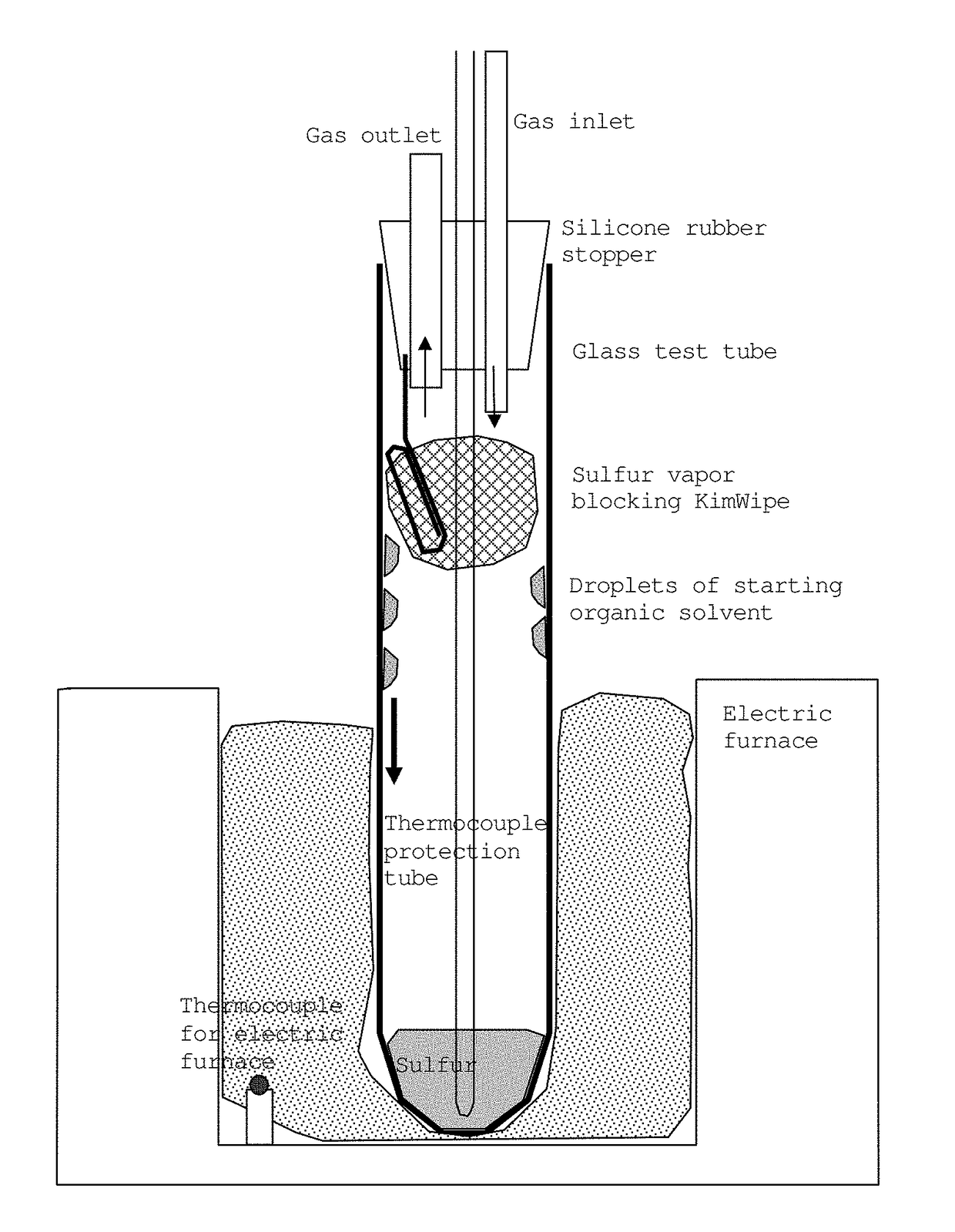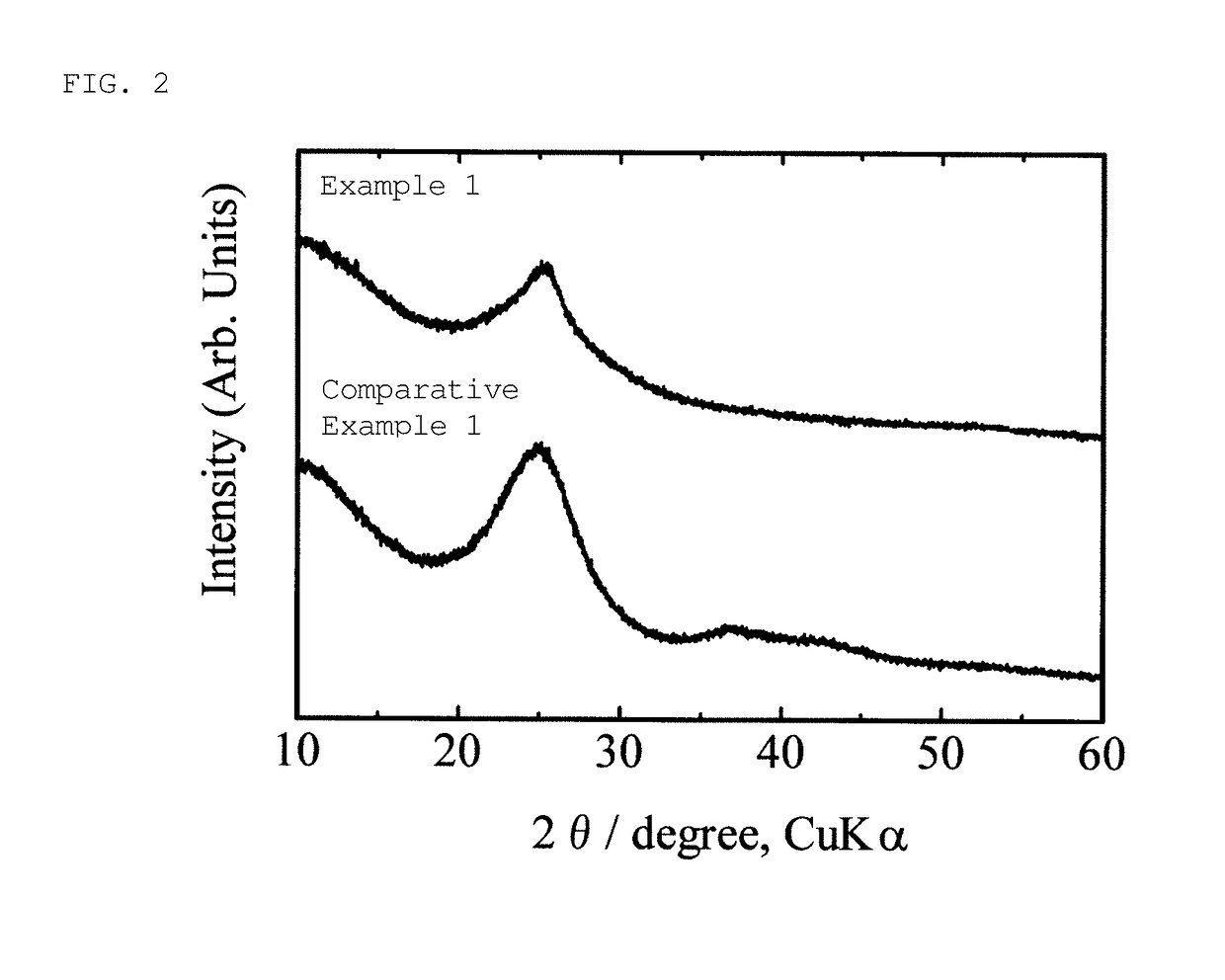Organic sulfur material and method for producing same
a technology of organic sulfur and sulfur dioxide, which is applied in the direction of carbon-sulfur compounds, sustainable manufacturing/processing, cell components, etc., can solve the problems of capacity reduction, low conductivity of elemental sulfur, lag in the high-capacity cathode of lithium-ion secondary batteries, etc., and achieve excellent charge-discharge characteristics, high capacity, and high conductivity
- Summary
- Abstract
- Description
- Claims
- Application Information
AI Technical Summary
Benefits of technology
Problems solved by technology
Method used
Image
Examples
example 1
1-Octanol (Non-Aqueous Electrolyte Lithium Secondary Battery)
[0108]Sulfur (Kishida Chemical Co., Ltd., purity: 99%) (5.065 g) and 1.6474 g of 1-octanol (Wako Pure Chemical Industries, Ltd., purity 98%) (the buoyancy correction was not made for weighing to the nearest 0.1 mg; the same applies hereinafter) were placed in a test tube (produced by Maruemu Corporation, A-30, 30 mm (diameter)×200 mm (length)), and a silicone rubber stopper provided with an alumina protective tube (SSA-S, inner diameter: 2 mm, outer diameter: 4 mm, length: 230 mm) was attached. This rubber stopper is provided with holes for introducing or discharging nitrogen gas, and a hole for inserting a thermocouple (FIG. 1). The lower part of the test tube, 100 mm from the bottom, was placed in the heating portion of an electric furnace, and heating was initiated while introducing nitrogen gas at a rate of 50 mL per minute. The upper part of the test tube was exposed to open air to be cooled. The thermocouple was posi...
example 2
1-Heptanol (Non-Aqueous Electrolyte Lithium Secondary Battery)
[0116]An organic sulfur material was produced as in Example 1, except that 1-heptanol was used as a linear or branched alcohol. Specifically, 4.1107 g of sulfur and 1.2121 g of 1-heptanol (Kishida Chemical Co., Ltd., purity: 98%) were placed in a test tube and heated to a sample temperature of 459° C. in an electric furnace under nitrogen gas stream (50 mL / min). At this time, the solution went up as a vapor to the upper part of the test tube, cooled off at the upper part, and adhered as droplets to the wall of the test tube; thus, 1-heptanol, which is a carbon source, was confirmed to be refluxing as a liquid. Then, after heating was stopped, the temperature was maintained at 300° C. or higher for 30 minutes (at 380° C. or higher for 10 minutes). The temperature was lowered to room temperature, and the obtained reaction product was heated under nitrogen stream at 300° C. for 2 hours to vaporize and remove the sulfur to th...
example 3
1-Hexanol (Non-Aqueous Electrolyte Lithium Secondary Battery)
[0124]An organic sulfur material was produced as in Example 1, except that 1-hexanol was used as a linear or branched alcohol. Specifically, 3.6000 g of sulfur and 1.2119 g of 1-hexanol (Kishida Chemical Co., Ltd., purity: 99%) were placed in a test tube and heated to a sample temperature of 450° C. in an electric furnace under nitrogen gas stream (50 mL / min). At this time, the solution went up as a vapor to the upper part of the test tube, cooled off at the upper part, and adhered as droplets to the wall of the test tube; thus 1-hexanol, which is a carbon source, was confirmed to be refluxing as a liquid. Then, after heating was stopped, the temperature was maintained at 300° C. or higher for 30 minutes (at 380° C. or higher for 10 minutes). The temperature was lowered to room temperature, and the obtained reaction product was heated under nitrogen stream at 300° C. for 2 hours to vaporize and remove the sulfur to thus ob...
PUM
| Property | Measurement | Unit |
|---|---|---|
| Temperature | aaaaa | aaaaa |
| Temperature | aaaaa | aaaaa |
| Energy | aaaaa | aaaaa |
Abstract
Description
Claims
Application Information
 Login to View More
Login to View More - R&D
- Intellectual Property
- Life Sciences
- Materials
- Tech Scout
- Unparalleled Data Quality
- Higher Quality Content
- 60% Fewer Hallucinations
Browse by: Latest US Patents, China's latest patents, Technical Efficacy Thesaurus, Application Domain, Technology Topic, Popular Technical Reports.
© 2025 PatSnap. All rights reserved.Legal|Privacy policy|Modern Slavery Act Transparency Statement|Sitemap|About US| Contact US: help@patsnap.com



